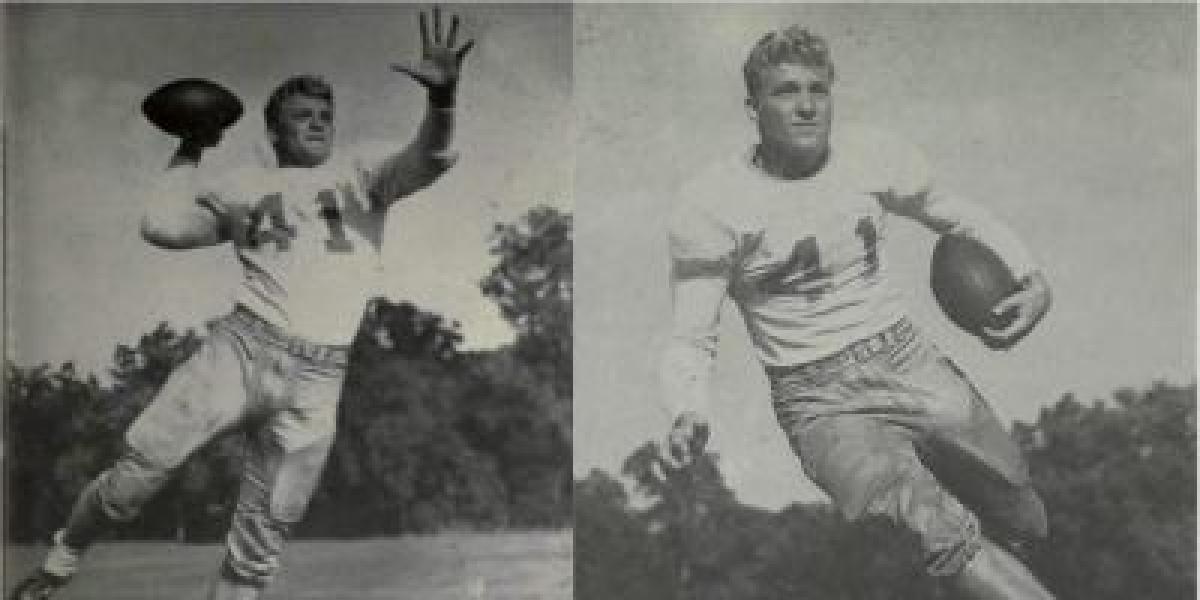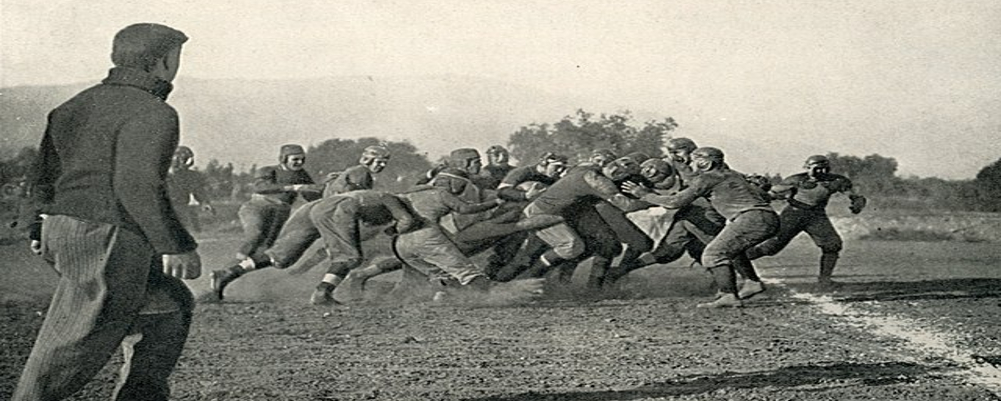The single-wing, known for its reliance on a powerful running back and a more static quarterback role, was giving way to the T-formation, which emphasized a mobile quarterback with a stronger passing presence. Join us as we explore the challenges and triumphs of Layne's position switch, and how it not only impacted his career but also foreshadowed the increasing importance of the quarterback position in the NFL. So, grab your playbook and get ready to analyze the fascinating story of Bobby Layne's transformation from wingman to T-formation titan!
Transcribed Conversation with Timothy Brown on Bobby Layne
Hello, my football friends. This is Darin Hayes of PigskinDispatch.com. Welcome once again to The Pig Pen, your portal to positive football history. And it's that time of the week again when we're going to visit Timothy Brown, the author and historian at Football Archeology, and see what he's up to with one of his famous daily tidbits.
And Tim Brown, welcome back to The Pig Pen.
Hey, thanks, Darin. Looking forward to chatting once again.
Yeah, this is a great weekly thing we got going on here. And Tim, before we get going into the tidbit, maybe you could, without giving away your secret sauce recipe here, tell us what your normal routine is for finding such interesting and off-the-wall topics for football for your writing. Yeah, you know, so I think, you know, some of it is really kind of planned out, and some of it's just happenstance or luck, I guess.
So, some of the topics are just things that, you know, I just have this the way my mind works a lot of times. I'm like, well, why is it this way? Why why do we do things this way? And so, you know, I just generally look at the game and ask the question and, you know, why do we call halfbacks, halfbacks and fullbacks, fullbacks and quarterbacks, quarterbacks? You know, I mean, just I ask kind of goofy questions like that. And so, anyways, as a result, you know, I just spend a lot of time researching football topics.
And so some of them are really kind of purposeful. I'm trying to find information on a specific thing. But oftentimes while I'm doing that, I just, you know, the article next to the one that I found, you know, for whatever I was researching happens to the headline that I noticed.
And that ends up being the more interesting article. So, you know, so and then other times just, you know, you're reading an article, and they're not just they don't just cover one topic. They talk about two or three things in an article.
And so sometimes the second or third topic is as interesting, more interesting than what I was really looking for. And so, you know, I just kind of notice them. And I have, you know, a couple of ways of tracking that information and kind of putting them in buckets. This is something I'm going to follow up on.
And once I'm done with the research I'm doing today. I just come up with judgments that are either worthy of a long article or a tidbit. Well, you really are quite the magician because I find myself quite often when you have that tidbit come out.
Yeah, I'm saying, you know, Tim's asking a question that I didn't even know that I wanted to know, but now I do want to know it. So it's something I never even thought of half the time. Like, wow, that's that's great.
This is really interesting. And it really dives into it. I think the listeners will enjoy that also.
And we'll give you a way to find Tim's tidbits here in a moment. But we're going to talk about one of his tidbits that really caught my eye back in early May. And it's on the great, legendary Bobby Lane and him switching some positions during his career.
Yeah, so this is an example of one that I kind of stumbled upon. I mean, I've always known about Bobby Lane and yada, yada. But, you know, I was I can't remember what I was looking for.
But at one point, I came across an article that said that leading into his senior season at Texas, he was going to be switching positions. And but he was just, you know, he was he played at a point when football was switching from the single wing and, to some extent, the Notre Dame box to the T formation. You know, so the T really came out.
You didn't say 1940 was really the word really bowed and then had the warrants that stopped some things. But so he's a post-war college kid, and his coach, Dana Bible at Texas, was a single-wing proponent. And so Lane was fullback slash halfback within the single wing.
And, you know, that was an offense that required. Required, I mean, the ideal was the Jim Thorpe, you know, triple threat, the guy who would who could kick, who could run, and who could pass. And Lane was all three of those.
You know, I mean, he was, you know, an absolute stud. The 46 Rose Bowl. He had three TVs rushing.
He had two passes and one receiving any kick for extra points, you know, which is, you know, 40 points every point in the game. He was a part of, you know. So, he was that kind of guy.
And, you know, some single-wing teams relied on their, most of them relied on their tailback to be the primary pastor. Some also had the fullback passing. You know, it depends on whether you have two talented pastors, and that's what you do.
But pretty much nobody had the quarterbacks pass the Notre Dame box. Yeah, they did. The Packers did that kind of stuff.
So anyway, they bring a new coach, and he installs the team. Oh, he looks around. He says, who's the best pastor on the team? Bobby Lane.
Boom. He became the quarterback during his senior year at Texas and was a total stud as a quarterback. But, you know, and it is because he was a great passer before.
You know, he's a great pastor in the single wing. So, he's a great pastor on the team. In some respects, he probably didn't utilize all his talents as well as a single wing did, but they wanted to move to the team.
OK, now I believe, you know, when he became professional, he went to the Pittsburgh Steelers, which is near and dear to my heart. And I think you even say that the Steelers were a single-wing offense at the time when they drafted Lane. I believe Jock Southern might have been the coach there and after the postwar days when they got Lane.
But then they they traded him away to the. Was it the Lions that they traded him to the Bears, the Bears, the Bears, who were a T formation team? It just seems odd to me. OK, he was a single wing in college, converted to the the the T formation and then a single wing offense drafts them and trades them to the T formation.
I'm just wondering, you know, a little bit curious about that. You know, it's part of my Steelers anxiety is part of that. But it's just a little interesting question.
I was wondering if maybe you knew. Yeah. So, you know, I think what happened there is that so he was drafted third overall by Steelers, and they were the last NFL team to be running the single league.
So that kind of tells you, maybe, you know. Maybe they should have thought it was an antiquated office at that time, right? It belonged as well. But that was the case.
But what was happening, too, is that right after the war, you had the All-American Football Conference. And so Lane also got drafted number two overall by the Baltimore Colts. So now he's in a situation where, OK, do I want to play for the Colts and the AFC, or do I play as a T formation quarterback, or do I go back single wing with the Steelers? And he basically told the Steelers he wasn't going to go play for him.
So, in order to recoup, you know, some value, the Steelers traded him to the Bears, who were one of the teams that pioneered the T formation back in 1940. OK, so he never played single-wing and professional. The Steelers traded him before he even played for him.
OK, that makes sense. OK, gotcha. Gotcha.
Because he wanted to be a T formation quarterback. Yeah, correct. Correct.
All right. That explains it. By then, you know, the NFL rules were, you know, a lot, you know, they were just more protective of quarterbacks.
They recognized the value, and they started just doing some things, liberalizing, blocking, et cetera, that just allowed quarterbacks to flourish and attract fans. And now we know what happened with NFL versus college games. Well, very interesting indeed, and a great glimpse back into both college and pro football history and one of the great players in Bobby Lane and Tim; why don't you tell people where they can find your daily tidbits and your website? Yeah, you can find the tidbits at www.footballarchaeology.com. You know, just hit the site and click on an article.
It'll give you the opportunity to subscribe. If you subscribe and you subscribe for free, you can. You'll get an email every day around seven o'clock in the evening with the tidbit or the full article.
That's what I published that day. There's also paid subscriptions that offer some additional value for those that are really into the stuff. And then or you can follow me on Twitter or Facebook using the same football archaeology name and but those, you know, potentially a few a few of my articles.
So I hope you subscribe. All right, folks, and if you're driving the car, don't try to stop and write it down or write it as you're driving. We're going to have it in the show notes.
So you can just come back later. And on PigskinDispatch.com, we'll get you right to Tim's site and to where his social medias are as well. So, Tim, thank you once again for this little glimpse into football history.
And we'll talk to you again next week.
Very good. We'll see you in seven days. Thanks.
Transcribed by TurboScribe.ai.




